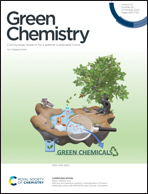Totally atom-economical synthesis of lactic acid from formaldehyde: combined bio-carboligation and chemo-rearrangement without the isolation of intermediates†
Abstract
Non-fermentative chemoenzymatic transformations have attracted great interest from both academia and industry. Here, we report a green chemoenzymatic cascade reaction that converts the C1 compound formaldehyde into lactic acid using a newly identified formolase variant and NaOH as catalysts with 100% atom economy and 82.9% overall yield under near-ambient conditions. The engineered formolase variant in this study exhibits a 19-fold substantially improved activity and improved formaldehyde resistance (up to 500 mM) and alters the main product from two-carbon glycolaldehyde (GA) to three-carbon dihydroxyacetone (DHA). The crystal structures of the parent formolase and identified variants were resolved to elucidate the molecular reason for the obtained improvement. Molecular dynamics simulation and molecular mechanics/generalized born surface area (MM/GBSA) analysis suggested that the identified amino acid substitutions allow more stable TPP-GA complexes in the active center of the dimeric formolase which is beneficial for the subsequent DHA generation.



 Please wait while we load your content...
Please wait while we load your content...